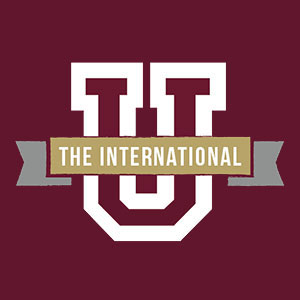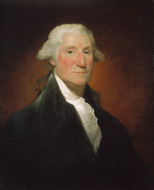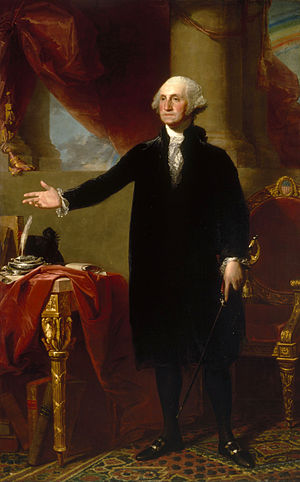Laredo Portrait Project Initiative a First for Laredo, TAMIU

ABOUT THE LAREDO PORTRAIT PROJECT
During the month of February, the City of Laredo, Texas will celebrate our nations’ first president with some firsts of its own as it presents the Laredo Portrait Project. This ambitious project, nearly four years in the making, will bring together the visual and performing arts to pay tribute to George Washington in a way never before seen in South Texas as part of the 116th Annual George Washington’s Birthday Celebration. Washington’s portraiture will serve as the unifying theme for the project.
The Portrait Project is an exceptional collaborative effort by leaders in the fields of business, politics, education, art, and history who share a desire to honor the man and the legend that was our nation’s first president. Sponsors include Texas A&M International University, the Harlan Crow Library of Dallas, IBC Bank, the City of Laredo, the Washington’s Birthday Celebration Association, the Guadalupe and Lilia Martinez Charitable Foundation, the Lucy Meriwether Chapter of the Daughters of the American Revolution, Southern Distributing Co., and Toni L. Ruiz.
ABOUT THE GILBERT STUART PORTRAIT OF GEORGE WASHINGTON
Gilbert Stuart (1755-1828) is revered as one of the greatest portrait artists in American history, immortalizing on canvas over a thousand of the most influential men and women of the 18th and early 19th century, including six U.S. presidents and notables such as General Henry Knox, Supreme Court Chief Justice John Jay and First Ladies Dolley Madison, Louisa Adams, Martha Washington and Abigail Adams.
Stuart and other artists of the Colonial era were understandably eager to capture the image of the immensely popular President Washington not just for posterity, but for profit as well. While artists of the day could reach the mass market with engravings based on their paintings, which were inexpensive in comparison, they didn’t have the option of using modern methods like photography for producing prints or posters that directly reproduced the original. Customers who wanted that look would purchase copies of the originals, made by the artist himself, who used the face from their first painting and simply changed the direction, clothing, background, etc. to produce additional copies, each an original in its own right.

THE VAUGHAN PORTRAIT
Stuart painted three iconic life portraits of Washington, all during his second term as president. The first, called the Vaughan portrait after Samuel Vaughan, owner of the first copy of this portrait, was originally painted in March, 1795 at the President’s House in Philadelphia on 6th and Market St. Some experts believe the Vaughan painting, which shows the 63 year-old president facing to the right, is the best of Stuart's portraits of Washington. Stuart never sold the original, but kept it and used it to paint copies from, which he then sold. This first copy that was owned by Samuel Vaughan is owned by the National Gallery of Art in Washington, D.C.

THE LANSDOWNE PORTRAIT
Historians note that George Washington had been besieged by painters for much of his life, so it is understandable that he intensely disliked sitting for portraits. Shortly after completing the Vaughan portrait, Washington reluctantly sat for Stuart a second time as a favor to Senator William Bingham of Pennsylvania, who commissioned the portrait as a gift of appreciation for the British Prime Minister, the Marquis of Lansdowne. The result was the "Lansdowne" portrait, completed in the fall of 1796 at Stuart's Philadelphia residence at 5th and Chestnut St. (now Signers Garden).
The Lansdowne is the only full-length portrait of the general not wearing a soldier’s uniform. Measuring 8 by 5 feet, the oil on canvas painting depicts Washington with his arm outstretched, wearing understated black. It is filled with inspirational symbolism of the new American republic. Washington's unusually clenched facial expression comes from his famous false teeth. The late William Sommerfield, legendary George Washington dramatic interpreter for the American Historical Theatre, described the meaning behind the painting: “I always think he’s saying, ‘We’ve created this new government, and now we’re handing it on to you, the next generation.’” The portrait depicts Washington as a representative of democracy, a man of the people, not as a ruler. The president stands beside a chair rather than a throne. An oval medallion of stars and stripes on the chair is draped with a laurel, a symbol of victory. On the floor, under the table, three books: “General Orders,” “American Revolution” and “Constitution & Laws of the United States.”
Observers of the Lansdowne might notice that something about it doesn't quite fit, and they would be right. The proportions are wrong. Washington was over six feet tall, yet in preparing the portrait prior to sitting with the president to paint his face, Stuart used a friend who was several inches shorter as a model for the body, arms and legs. The outstretched hand belonged to Stuart himself. (Stuart used a wax cast of his own hand, which was much smaller than Washington’s.)
The Lansdowne is the subject of the famous story of First Lady Dolley Madison’s brave rescue of the Washington portrait from the White House during the War of 1812, just before British soldiers captured and burned the presidential mansion on August 24, 1814. After the incident, which destroyed the interior and charred much of the exterior of the mansion, reconstruction began almost immediately. Several copies of the portrait were then commissioned, including the one hanging today in the White House East Room.
After purchasing the original Lansdowne from its British owner in 2000, the National Portrait Gallery allowed it to tour the U.S. for the last time in 2002. Many Laredoans still recall traveling to Houston to get a glimpse of the celebrated portrait when it was on display in Houston’s Museum of Fine Arts during its final national tour.

THE ATHENAEUM PORTRAIT
The third time was definitely the charm for Gilbert Stuart when it came to painting George Washington. The two previous works proved to be so successful that Martha Washington commissioned Stuart to paint a pair of portraits of her and her husband for their Virginia home, Mount Vernon. Shortly after completing the Lansdowne portrait n 1796, Stuart painted what would become his best known and most reproduced image, a depiction of the left side of Washington’s face known as the “Athenaeum” portrait, named after the Boston library that acquired it after Stuart’s death.
In order to escape the large number of visitors who came to see his work and offer his subjects a more tranquil setting, Stuart leased a farmhouse in Germantown, north of Philadelphia. He converted the barn of this house into his “painting room.” It is here that Stuart painted the famous Athenaeum portrait in the fall of 1796.
Stuart was very pleased with the results and, recognizing that the portrait of Washington in particular would be extremely popular with the public as well, left it unfinished so that he could use it as a model to create replicas. He even used it to replace the heads on reproductions of his two earlier paintings of Washington. Stuart painted at least 70 known replicas of George’s Athenaeum portrait (he never copied Martha’s) and sold them for one hundred dollars apiece.
Stuart never delivered either canvas to the Washingtons, in spite of numerous attempts by the President to recover it. Some accounts note that eventually, Washington told Stuart to “Keep them as long as you like.” Stuart did just that, keeping the unfinished portraits in his studio for the rest of his life.
The pair of portraits remained in possession of the Boston Athenaeum until 1980, when they were acquired jointly by the Museum of Fine Arts, Boston and the National Portrait Gallery, Washington, D.C. The Athenaeum portrait appears on the U.S. one dollar bill as well as various postage stamps. It is fitting that this portrait inspired the official logo for the Washington’s Birthday Celebration Association.
ABOUT THE AMERICAN HISTORICAL THEATRE PERFORMANCE OF “PORTRAIT OF A PATRIOT”
The public is invited to attend a theatrical first for our community as Washington’s Birthday Celebration Association presents the American Historical Theatre’s national premier of “Portrait of a Patriot.” The play, specially commissioned for the Portrait Project, will explore Washington’s life and the role his portrait artist, Gilbert Stuart, played in the way we envision and understand him today. Curtain time is 7:00 p.m. on Wednesday, February 13.
After the performance, audience members will have a chance to get “up close and personal” with George Washington, portrayed by John Lopes, and Gilbert Stuart, portrayed by Bob Gleason, during a question and answer session after the performance.
Whether you’re a history buff, science aficionado, computer wizard, art enthusiast, or theater lover, the Portrait Project offers something for everyone. TAMIU President Dr. Ray M. Keck III invites the community to visit the Mount Vernon and Stuart exhibits and attend the AHT performance. “It is an incomparable educational, cultural, and entertainment experience you won’t want to miss.”
ABOUT GEORGE WASHINGTON:
Henry Lee III, father of American Civil War General Robert E. Lee and cavalry officer in the Continental Army during the American Revolution, eulogized President George Washington as “first in war, first in peace, and first in the hearts of his countrymen.” But the list of firsts related to the Father of Our Country doesn’t end there.
Washington was the leader of the first successful revolution against a colonial empire in world history. He was the first person (and first Mason) to serve as president of the United States under the Constitution, serving two consecutive terms from 1789 to 1797. He was the first presidential candidate to run without political party affiliation and the first and only president to be elected unanimously by the Electoral College, receiving all 69 electoral votes cast.
The state of Washington, named after him, is the only state to be named after an American. Although Washington, D.C., the city that eventually claimed the official residence of the president of the United States, was similarly named after him, George Washington was the only U.S. president who did not live in the White House. He is also the only U.S. president to be inaugurated in two different cities (New York and Philadelphia). In 1883, this American icon was suitably immortalized as the first president to have his image on a U.S. postage stamp.
Before this military hero became the Commander in Chief of the Continental Army that won independence for the United States, Washington fought for the British in the French and Indian War as a member of the Virginia militia. In the 1750’s, Colonel Washington took his penchant for fashionable attire to the battlefield with him by becoming the first commanding officer to design uniforms for the Virginia militia. The unit became known as the “Virginia Blues,” a nickname arising from their color-coordinated outfits, which sought to emulate those of King George II’s professional soldiers.
In addition to his skills as a military and political leader, George Washington was also a pioneering farmer. He sought to advance farming and agricultural techniques by using new fertilizers, advanced systems of crop rotations, and innovative farm equipment. As a farmer, George Washington is credited with being the first to introduce the mule to America. Although he kept slaves to assist with his farm and maintained slave quarters on his Mount Vernon estate, Washington was the first and only Founding Father to free his slaves. Even after his death on December 14, 1799, his estate continued to pay for the care of his former slaves.
Journalists who need additional information or help with media requests and interviews should contact the Office of Public Relations, Marketing and Information Services at prmis@tamiu.edu